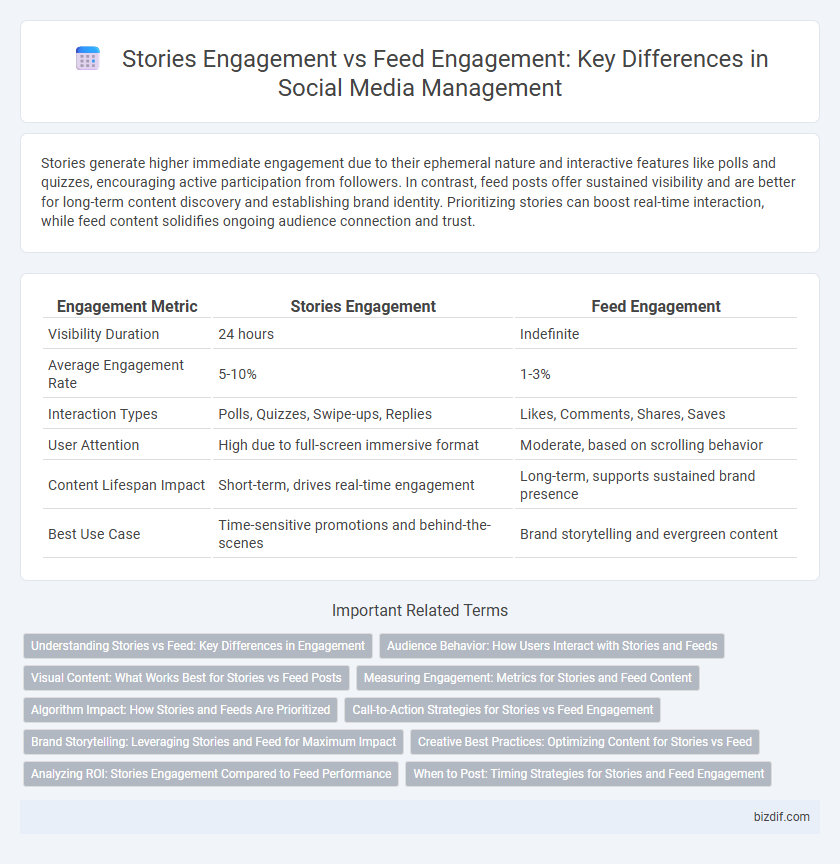Stories generate higher immediate engagement due to their ephemeral nature and interactive features like polls and quizzes, encouraging active participation from followers. In contrast, feed posts offer sustained visibility and are better for long-term content discovery and establishing brand identity. Prioritizing stories can boost real-time interaction, while feed content solidifies ongoing audience connection and trust.
Table of Comparison
| Engagement Metric | Stories Engagement | Feed Engagement |
|---|---|---|
| Visibility Duration | 24 hours | Indefinite |
| Average Engagement Rate | 5-10% | 1-3% |
| Interaction Types | Polls, Quizzes, Swipe-ups, Replies | Likes, Comments, Shares, Saves |
| User Attention | High due to full-screen immersive format | Moderate, based on scrolling behavior |
| Content Lifespan Impact | Short-term, drives real-time engagement | Long-term, supports sustained brand presence |
| Best Use Case | Time-sensitive promotions and behind-the-scenes | Brand storytelling and evergreen content |
Understanding Stories vs Feed: Key Differences in Engagement
Stories generate higher immediate engagement with features like polls and swipe-ups, fostering direct interaction and real-time feedback. Feed posts maintain longer visibility and encourage sustained engagement through comments and shares, contributing to brand awareness over time. Analyzing metrics such as completion rates for Stories and click-through rates for Feed posts reveals distinct audience behaviors critical for optimizing content strategy.
Audience Behavior: How Users Interact with Stories and Feeds
Users engage with Stories through quick, immersive interactions such as polls, questions, and swipe-ups, which foster real-time audience participation and immediate feedback. Feed engagement tends to be more deliberate, involving likes, comments, and shares that reflect deeper content consumption and longer attention spans. Understanding these distinct behaviors helps optimize content strategies to maximize reach and interaction on platforms like Instagram and Facebook.
Visual Content: What Works Best for Stories vs Feed Posts
Visual content in Stories thrives on short, dynamic videos and interactive elements like polls and stickers, driving higher engagement through real-time, immersive experiences. Feed posts perform best with high-quality images, carousel posts, and well-composed visuals that encourage likes and comments over time. Optimizing for platform-specific formats ensures Stories capture immediate attention while Feed posts foster sustained user interaction.
Measuring Engagement: Metrics for Stories and Feed Content
Measuring engagement for social media Stories involves tracking metrics such as completion rates, swipe-ups, replies, and sticker interactions, which highlight viewer interaction within the ephemeral content. In contrast, Feed engagement is assessed through likes, comments, shares, and saves that indicate lasting user interaction with published posts. Comparing these metrics provides insights into content performance, audience behavior, and optimal posting strategies for enhancing overall social media presence.
Algorithm Impact: How Stories and Feeds Are Prioritized
Social media algorithms prioritize Stories for real-time engagement, boosting visibility through their ephemeral nature and immediate interaction rates. Feeds receive algorithmic preference based on post relevance, historical user interactions, and content type, fostering sustained engagement over time. Brands leveraging Stories observe higher short-term engagement spikes, while Feed posts contribute to long-term audience retention and discovery.
Call-to-Action Strategies for Stories vs Feed Engagement
Call-to-action strategies for Stories leverage interactive features like polls, swipe-ups, and question stickers, driving immediate user responses and higher engagement rates compared to Feed posts. Feed engagement focuses on compelling captions, hashtags, and visual appeal to encourage likes, comments, and shares over a longer viewing period. Optimizing CTAs for Stories fosters real-time interaction, while Feed CTAs build sustained community involvement.
Brand Storytelling: Leveraging Stories and Feed for Maximum Impact
Brand storytelling thrives on the unique strengths of Stories and Feed engagement, with Stories offering real-time, interactive experiences that foster immediate emotional connections and enhance brand authenticity. Feed posts provide lasting visual narratives that build brand identity over time through curated content and strategic use of hashtags, boosting discoverability and sustained audience interaction. Balancing dynamic, ephemeral Stories with consistent, high-quality Feed content maximizes reach, deepens audience engagement, and drives long-term brand loyalty.
Creative Best Practices: Optimizing Content for Stories vs Feed
Stories engagement thrives on visually dynamic, short-form content with interactive features like polls, stickers, and swipe-ups, driving immediate viewer interaction. Feed engagement benefits from high-quality, polished images and captions with relevant hashtags to enhance discoverability and foster long-term audience connection. Prioritizing vertical formats for Stories and consistent branding for Feed posts maximizes content effectiveness across platforms.
Analyzing ROI: Stories Engagement Compared to Feed Performance
Analyzing ROI for social media reveals that Stories engagement often produces higher interaction rates per impression compared to Feed posts due to their ephemeral and immersive nature. Conversion metrics from Stories, such as swipe-ups and direct replies, offer clearer insights into immediate user actions, enhancing ROI tracking accuracy. Feed engagement drives sustained brand awareness and longer content lifespan, but Stories deliver more measurable short-term ROI for campaigns focusing on direct response and time-sensitive offers.
When to Post: Timing Strategies for Stories and Feed Engagement
Posting Stories during peak activity hours, typically mornings and late evenings, maximizes immediate visibility and real-time interactions, while Feed posts perform better when scheduled around midday to early afternoon when users browse more deliberately. Leveraging analytics to identify when your specific audience is most active on platforms like Instagram and Facebook ensures optimized timing tailored to your content type. Consistent timing combined with relevant, engaging content drives higher retention and interaction rates across both Stories and Feed posts.
Stories engagement vs Feed engagement Infographic

 bizdif.com
bizdif.com